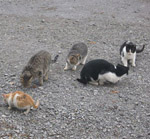The fate of tall grass prairie remnants in North America...
 Tall grass prairie remnant in the Desoto National Widlife Refuge, Iowa-Nebraska area. Image credit, US Fish and Wildlife Service.
Tall grass prairie remnant in the Desoto National Widlife Refuge, Iowa-Nebraska area. Image credit, US Fish and Wildlife Service.
North American tall grass prairie holds an unfortunate distinction of having faced one of the highest conversion rates of any ecosystem in the world. In Manitoba, 99% of the historic tall grass prairie has been lost, mostly to agriculture.
So if 99% is gone, how is the remaining 1% making out? In a new study to be published in the journal Biological Conservation, scientists try to answer this question.
The researchers revisited remnant prairie patches, which had previously been evaluated in 1987 and 1988 using a semi-qualitative methodology (i.e. a grading system based on indicators such as relative cover invasive species, level of human disturbance, etc.)
The new study applied the same evaluation method to the sites twenty years later. Sadly they found that 15 of the original patches (23%) had been converted to a non-prairie land cover. In addition, 9 patches (13.8%) had been degraded from invasive species infestation to the point that they were no longer tall grass prairie.
On average, the quality grade of the remnant prairie decreased significantly from 1987 to 2006 with the smaller patches experiencing a greater level of deterioration. The authors acknowledge the possibility of observer bias given that different people administered the evaluations twenty years apart, but they took steps to minimize this potential problem.
The study also conducted more detailed studies of 24 remnant prairie patches in 2007 and 2008 to better understand the reasons for the changes. They found that abundance of invasive species was greater as habitat edge increased. Given that smaller patches have a greater proportion of edge, this finding may help explain the pattern of remnant prairie loss.
However, the results were not entirely doom and gloom. The study also found that the largest patches increased in size, and overall there was a net increase in the total area of tall grass prairie.
Conversely all the patches that were lost were less than 11 hectares. The researchers speculate that conservation organizations may be focusing preservation and restoration efforts on larger sites leading to better outcomes for these areas.
So if larger patches are getting bigger and smaller patches are disappearing, then what is the prognosis for the future of North American tall grass prairie?
Unfortunately, most of the remaining areas of tall grass prairie patches in Manitoba are small. So if they hold to the trend observed in the study (and these results are generalizable to other parts of North America), we could be in big trouble. The researchers write:
"Given the evidence of both recent changes over time, and observed effects of patch structure on native and alien species, it seems probable that most remaining northern tall-grass prairies are not self-sustaining or likely to persist over time. Overall, active management is clearly needed to conserve remnant patches of a once larger and contiguous North American ecoregion"
--Reviewed by Rob Goldstein
Koper, N., et al. (2009). Recent declines in northern tall-grass prairies and effects of patch structure on community persistence Biological Conservation




 Grassland
Grassland
Reader Comments